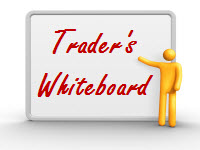 If you’ve made it this far through the series, you’ve learned the basics: reading charts, spotting trends, implementing stops, but what now?
If you’ve made it this far through the series, you’ve learned the basics: reading charts, spotting trends, implementing stops, but what now?
Today Adam shows you what you need to do to tie all of this information together. Becoming a more effective, organized, and successful trader is just one short video away.
Click here to watch Lesson 5 in the Trader's Whiteboard series and take the next step in order to trade like the pros.
Enjoy!
The MarketClub Team

Goodmorning, al the way from Belgium Europe
Yesterday it was very volatile trading in Europe before the good news about the news jobs in the US came out.
This day proved again that without placing stops I would have made great losses.
To decide the stop price I use the ATR Average True Range wich tells you what the range of volatility per timetable is.
As an extra safety I multiply this value 1.5 or 2 times and this is my stop value so the price I place under my buying price.
Often I take the Limit Price two tmes higher.
Regards Mar Tielbek
Mar,
Thanks for your feedback.
Adam
Hi I am really loving lesson five having a game plan.
olá gostei mui bom esse vidio sucesos para todos destes vidios ok Renivaldo AVES
Thanks for the great advice.
hi adam. what is your latest thinking on how to avoid a major hit after your stop is triggered as happened on the "flash crash" day last may.
Henry,
Thank you for your feedback on how to avoid the major hit after flash crash.
Here's my answer, I would strongly recommend using money management and protective stops at all times. Some would argue that stops a not important, however, I believe they're very important to every investor to have in their arsenal of trading tools.
You will find this post that we have on money management stops very useful.
Here's the link that you need:http://club.ino.com/trading/2009/06/how-to-use-money-management-stops-effectively/
Every success in 2011.
Adam
Hello Adam and Happy New Year to you and your great staff
It's always a good idea to review the simple things. "Let me do the simplest things perfectly so that I may do the more complicated things better."
As a swing trader, paying great attention to monthly triangles, I don't really know how to figure out a target price, except perhaps by using fibonacci levels. But even then, nobody knows how far up or down a stock or index may go.
It is my thought that once you are riding a trend and have a solid profit, you can forget about a price objective altogether and rely totally on your stop. As your profit grows, you can afford to widen your stop progressively so that you can both preserve a profit but at the same time ride out a bump on the trend - rather than selling and buying back in and thereby enriching your broker.
I'd be interested in your thoughts on this policy.
Tango6,
Thank you for your feedback.
You may be interested in this post that we have on money management stops.
Here's the link that you need:http://club.ino.com/trading/2009/06/how-to-use-money-management-stops-effectively/
Every success in 2011.
Adam
Hello,
I just have seen Lesson 5 that says it is important to put a stop.
Other traders that trade on a one or two day trade say do not put a stop.
My expierience is also that I lose a lot of money because of the stops while very often just after a stop was reached the stock rose so left me frustradet.
So maybe you can be more specific about how to manage or place these stops.
Please youre reaction,
regards from Mar Tielbek
Mar,
Thank you for your feedback.
It is very important when you trade is to use some form of its money management. Not to do so, puts your entire equity at risk in a relatively short period of time.
Every investor is different in terms of their risk profile. That is why we have a separate blog posting on money management stops. Here's the link you need to learn more about the subject: http://club.ino.com/trading/2009/06/how-to-use-money-management-stops-effectively/
I hope this helps you in 2011. May the New Year bring you much success.
Adam